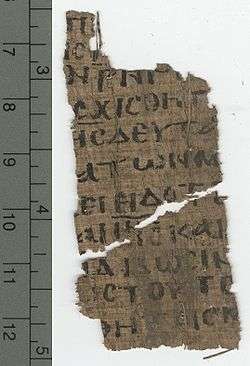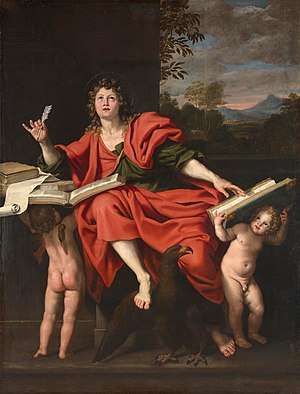John 21
John 21 is the twenty-first and final chapter of the Gospel of John in the New Testament of the Christian Bible. It contains an account of a post-crucifixion appearance in Galilee, which the text describes as the third time Jesus had appeared to his disciples. In the course of this chapter, there is a miraculous catch of 153 fish, the confirmation of Peter's love for Jesus, a foretelling of Peter's death in old age, and a comment about the beloved disciple's future.
| John 21 | |
|---|---|
Acts 1 → | |
 John 21:11–14, 22–24 in Papyrus 122 (4th/5th century) | |
| Book | Gospel of John |
| Category | Gospel |
| Christian Bible part | New Testament |
| Order in the Christian part | 4 |
| Part of a series of articles on |
| John in the Bible |
|---|
 |
| Johannine literature |
| Authorship |
| Related literature |
| See also |
Text
The original text was written in Koine Greek. This chapter is divided into 25 verses.
Textual witnesses
Some early manuscripts containing the text of this chapter are:[1]
- Papyrus 66 (c. AD 200; extant verses 1-9, 12, 17)
- Papyrus 109 (3rd century; extant verses 18-20, 23-25)
- Codex Vaticanus (325–350)
- Codex Sinaiticus (330–360; complete)
- Papyrus 122 (4th/5th century; extant verses 11–14, 22–24)
- Codex Bezae (c. 400)
- Codex Alexandrinus (400–440)
- Papyrus 59 (7th century; extant verses 7, 12–13, 15, 17–20, 23)
Appendage?
Verse 1
- After these things, Jesus revealed himself again to the disciples at the sea of Tiberias. He revealed himself this way.[2]
In the previous chapter of John's Gospel, the text summarizes the many signs which Jesus performed for his followers, not all of which could be recorded in the Gospel. John 21 begins with the 'Johannine transition', After these things... (Greek: Μετὰ ταῦτα, romanized: meta tauta) which is used frequently in the Fourth Gospel,[3] leading some scholars to suggest that John 21 was appended in the same way as Mark 16:9–20. Peter's ecclesiastical role is emphasized, but this is similar to Peter's commissioning in John 1.[4]
Westcott proposed a theory that the author simply decided to add an additional incident at some time after writing the book, but before final publication. Donald Guthrie writes:
It is unlikely that another author wrote this section since there are several points of contact in it with the style and language of previous chapters...(IVP New Bible Commentary)
The Church Father Tertullian wrote, "And wherefore does this conclusion of the gospel affirm that these things were written unless it is that you might believe, it says, that Jesus Christ is the son of God?", which describes the end of Chapter 20, not Chapter 21. However, no existing manuscript of the Gospel omits this chapter.[5][6]
Manuscript evidence
The Nestle-Aland Novum Testamentum Graece (27th ed.) as well as major translations of the New Testament (e.g. KJV, NASB, NIV, RSV, NRSV) retain this chapter in their editions as original.
In an essay, contributed on behalf of scholars unconvinced of any decisive sense of "originality" to John 21 (published in 2007), Felix Just wrote: "We (unfortunately!) do not possess any ancient manuscript of John that actually ends at 20:31."[7] In other words, ancient manuscripts that contain the end of John 20 also contain text from John 21. So if John 21 is an addition, it was so early (which is not in doubt: part of John 21 appears in P66) and so widespread, that no evidence of the prior form has survived. This should however be balanced against the tendency for the first and last pages of codices to be lost: there are just four papyrus witnesses to John 20–21, only three of which date from the 4th century or earlier.[1]
Novum Testamentum Graece (NA28) and the United Bible Societies (UBS5) provide the critical text for John 21.[8]
In 2006 one 4th-century Sahidic papyrus manuscript (Bodleian MS. Copt.e.150(P)) came to light that it may end at 20:31,[9] but this is not conclusive due to its fragmentary state.[10]
The Disciple whom Jesus loved
The description of the "beloved disciple's" (normally assumed to be John the Apostle) fate is presented as an aside to Peter. Jesus says that it is not Peter's concern, even if Jesus should wish that that disciple remain alive until the end of time. The following verse clarifies that Jesus did not say "This disciple will not die", but that it was not for Peter to know.
The last appearance of the 'Disciple whom Jesus loved' in this Gospel, together with his first appearance in chapter 1 form a literary "inclusio of eyewitness testimony" to privilege this witness (in the Gospel of John 21:24) over Peter's, not to denigrate Peter's authority, but rather to claim a distinct qualification as an 'ideal witness' to Christ, because he survives Peter and bears his witness after Peter.[11][12] The inclusio also reinforces the Beloved Disciple’s unique status among the disciples: He has followed and remained with Jesus from beginning to end.[13] Bauckham notes the occurrence of at least two specific words in the narratives of both the first and the last appearance of this disciple: "to follow" (Greek: ἀκολουθέω 'akoloutheó') and "to remain/stay" (Greek: μένω 'menó').[14] In the first chapter verse 1:38 it is stated that "Jesus turned, and seeing them following ('akolouthountas'), said to them, "What do you seek?"", then in verse 1:39 they "remained ('emeinan') with Him that day".[14] In John 21, the last appearance of the 'Disciple whom Jesus loved' is indicated using similar words: in verse 21:20 it is written that "Peter, turning around, saw the disciple whom Jesus loved following ('akolouthounta')", then in verse 21:22 "Jesus said to him [Peter], "If I will that he remain ('menein') till I come, what is that to you?"[14] The appearances are also close to Peter's, as the first one, along with Andrew, happened just before Peter's, who was then given the name 'Cephas' (alluding to Peter's role after Jesus' departure), and the last one, just after Jesus' dialogue with Peter, acknowledging the significance of Peter's testimony within "the Petrine's inclusio", which is also found in the Gospel of Mark and Luke (see Luke 8 under "The Women who sustained Jesus").[15]
Verses 24–25
The chapter (and the whole book) is closed by two verses referring to the author of the gospel in the third person ("We know that his testimony is true").
Verse 24
- This is the disciple who is bearing witness about these things, and who has written these things, and we know that his testimony is true.[16]
Verse 25
- And there are also many other things that Jesus did, which if they were written one by one, I suppose that even the world itself could not contain the books that would be written. Amen.[17]
See also
- Overview of resurrection appearances in the Gospels and Paul
- Pericope Adulterae
- Related Bible parts: Mark 16, Luke 24, John 1
References
- Papyri and Manuscripts related to the Gospel and Epistles of John in The Johannine Literature Web at Catholic-Resources.org.
- John 21:1 WEB
- John 2:12, 3:22, 5:1, 6:1, 6:66, 7:1, 11:7, 19:28, 21:1
- John 1:42
- Helmut Koester, Introduction to the New Testament (Walter de Gruyter 2000 ISBN 978-3-11014970-8) vol. 2, p. 192
- Chris Keith, The Pericope Adulterae, the Gospel of John, and the Literacy of Jesus (Brill 2009 ISBN 978-9-00417394-1), p. 258
- Felix Just, 'Combining Key Methodologies in Johannine Studies', in Tom Thatcher (ed), What We Have Heard from the Beginning: The Past, Present, and Future of Johannine Studies, (Baylor University Press, 2007), p. 356.
- Nestle-Aland Novum Testamentum Graece, Jn 21
- Gesa Schenke, 'Das Erscheinen Jesu vor den Jüngern und der ungläubige Thomas: Johannes 20, 19–31' in Louis Painchaud and Paul-Hubert Poirier, eds, Coptica – Gnostica – Manichaica: Mélanges offerts à Wolf-Peter Funk (Les presses de l'Université Laval / Peeters, 2006) pp. 893–904.
- Kok, Michael J. (2017). The Beloved Apostle?: The Transformation of the Apostle John into the Fourth Evangelist. Wipf and Stock Publishers. p. 32. ISBN 9781532610219.
- Bauckham 2017, pp. 128–129.
- Bauckham, R. "The Beloved Disciple as Ideal Author," JNST 49 (1993) 21-44; reprinted in S. E. Porter and C. A. Evans, eds., The Johannine Writings (Biblical Seminar 32; Sheffield: Sheffield Academic, 1995) 46-68; apud Bauckham 2017, p. 128
- James L. Resseguie, “The Beloved Disciple: The Ideal Point of View,” in Character Studies in the Fourth Gospel: Narrative Approaches to Seventy Figures in John, ed. Steven A. Hunt, D. Francois Tolmie and Ruben Zimmermann (Tübingen: Mohr Siebeck, 2013); reprint (Grand Rapids, MI: Eerdmans, 2016), 548.
- Bauckham 2017, p. 128.
- Bauckham 2017, pp. 129.
- John 21:24 ESV
- John 21:25 NKJV
Sources
| Wikimedia Commons has media related to Gospel of John - Chapter 21. |
- Bauckham, Richard (2017). Jesus and the Eyewitnesses (2nd ed.). Wm. B. Eerdmans Publishing. ISBN 9780802874313.CS1 maint: ref=harv (link)
External links
- John 21 King James Bible - Wikisource
- English Translation with Parallel Latin Vulgate
- Online Bible at GospelHall.org (ESV, KJV, Darby, American Standard Version, Bible in Basic English)
- Multiple bible versions at Bible Gateway (NKJV, NIV, NRSV etc.)
| Preceded by John 20 |
Chapters of the Bible Gospel of John |
Succeeded by Acts of the Apostles 1 |